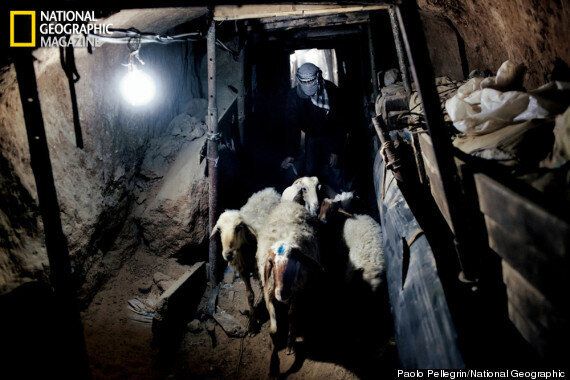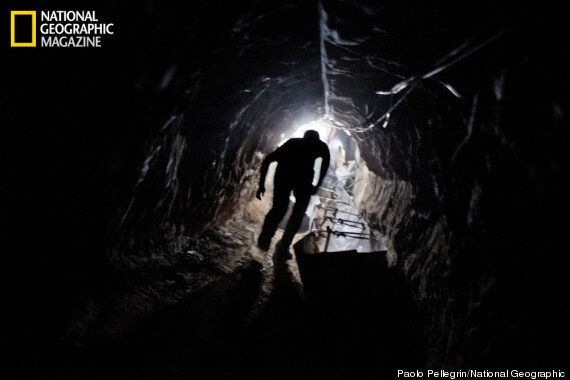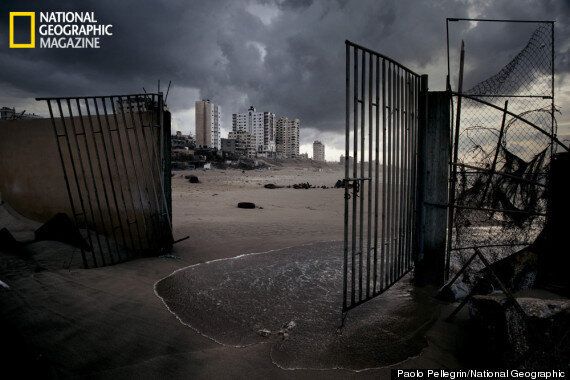The illegal underground tunnels that connect Gaza and Egypt are both an economic lifeline and a death trap.
James Verini and photographer Paolo Pellegrin reported from Gaza for National Geographic Magazine, exploring their successes, dangers and ingenuity.
"After Israel introduced the blockade, smuggling became Gaza’s alternative. Through the tunnels under Rafah came everything from building materials and food to medicine and clothing, from fuel and computers to livestock and cars.

Lamb is a luxury most Gazans can afford only on important Muslim holidays. With many farms devastated by war, and with other land lying unproductive in areas restricted by Israel, livestock comes in by tunnel from Egypt
"Hamas smuggled in weapons. New tunnels were dug by the day — by the hour, it seemed — and new fortunes minted. Families sold their possessions to buy in.
"Some 15,000 people worked in and around the tunnels at their peak, and they provided ancillary work for tens of thousands more, from engineers and truck drivers to shopkeepers.
"Today Gaza’s underground economy accounts for two-thirds of consumer goods, and the tunnels are so common that Rafah features them in official brochures."

A worker emerges from one of hundreds of smuggling tunnels that connect the Gaza Strip and Egypt
Even lions can be smuggled through the tunnels, though this is not without its dangers.
"One operator told of the time he tried to smuggle in a lion for a Gaza zoo. The animal was improperly sedated, awoke in the tunnel mid-trip, and tore one of the workers apart."
Even before the latest round of violence, Israel has tried hard to stamp out the smuggling.
"The Israeli military, knowing that the tunnels were used for arms trafficking, began demolishing homes that harbored tunnels.

Gaza City apartments rise beyond the broken gates of a waterfront restaurant. The beach once bustled with fishing boats and cafés, but the Israeli naval blockade, sewage, and lack of resources for rebuilding have taken their toll
"According to Human Rights Watch, some 1,700 homes were destroyed from 2000 to 2004."
Over the last week Israeli jets have been pounding the tunnels, no doubt destroying many. The Israelis are well aware that the tunnels are used by Hamas to smuggle weapons.
"Gaza is the heart of Palestinian resistance. It’s been the launching area for a campaign, now in its third decade, of kidnappings, suicide bombings, and rocket and mortar assaults on Israel by Gazan militants—much of this sanctioned, if not expressly carried out, by Hamas.

Members of the militant group Islamic Jihad patrol the border with Israel to prevent incursions by the Israel Defense Forces. The average Gazan family has six people, and with so few jobs to be had, disaffected young men are drawn to extremist groups
"One afternoon I interviewed an Islamic Jihad fighter at a patrol ground near Bayt Hanun. Wearing head-to-toe camouflage and a headband advertising his willingness to die for Allah, an AK-47 in his hands, and a 9mm pistol strapped to his chest, he admitted that most days he studies business administration at the university. “Jihad is not a job,” he said."
The full article and more pictures can be viewed in the December issue of National Geographic Magazine and a gallery can be viewed here.
